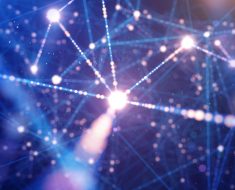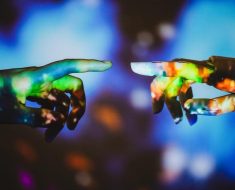A song composed by an algorithm? A masterpiece created by a collaboration between an artist and a machine? A story written by a large language model? The impact of AI in the creative industry has made all of this possible.
AI is revolutionizing creativity – and our concepts of what art, music writing, or film actually means. AI is playing an increasingly prominent role in the creative industry, from creating beautiful visuals to writing symphonies.
After AI-generated painting sells for more than $432,000 at auction; How is artificial intelligence altering creativity and what does it mean to be an artist in the world of innovation?
Let’s find out together in this article.
The Evolution of AI in Creativity
So where did it all start?
AI’s journey in the creative industry began modestly with algorithmic art in the 1960s. Artists and computer scientists experimented with mathematical algorithms to generate abstract art. These early endeavors laid the groundwork for the sophisticated AI tools we see today.
Today, AI has evolved into a powerful collaborator in creative processes. From neural networks to deep learning algorithms, AI systems can analyze vast amounts of data, recognize patterns, and produce original content.
AI’s capabilities are indeed expanding rapidly, from generating realistic images to crafting intricate music compositions.
| Period | Milestone |
|---|---|
| 1960s | Emergence of algorithmic art with pioneers like Harold Cohen and his program, AARON |
| 1970s-1980s | Advances in computer graphics and procedural generation |
| 1990s | AI’s entry into music and literature with programs like EMI and RACTER |
| 2000s | Rise of machine learning and neural networks, introduction of GANs |
| 2010s | AI as a creative collaborator, development of tools like DeepArt, Jukedeck, and Grammarly |
| 2020s and Beyond | Hyper-realistic art and animation, personalized creative experiences, focus on ethical AI |
AI Tools Transforming the Creative Industry
Visual Arts
Style Transfer and Image Generation
Tools like DeepArt and RunwayML use neural networks to apply the styles of famous artists to photographs, creating unique works of art. For example, an ordinary photo can be transformed to mimic the brushstrokes of Van Gogh or the surrealism of Dali.
These tools analyze the visual elements of a style and replicate it in new creations, enabling artists to experiment with different artistic expressions.
Creative Design and Illustration
AI-powered platforms like Canva and Adobe’s Sensei offer advanced design capabilities. Canva’s user-friendly interface, combined with AI, allows even those with no design experience to create professional-quality graphics.
Adobe Sensei, integrated into Adobe Creative Cloud, enhances tools like Photoshop and Illustrator with features like content-aware fill, which intelligently removes objects from images and fills in the background seamlessly.
Music Composition
AI Composers
Tools like Amper Music and AIVA (Artificial Intelligence Virtual Artist) are revolutionizing the music industry. Amper Music enables users to create custom music tracks by choosing style, mood, and length. The AI then generates a piece that fits these parameters.
AIVA, on the other hand, has composed original music used in film scores and video games. It can generate compositions in various styles, from classical to electronic, helping musicians and producers explore new creative directions.
Personalized Music Experiences
AI-driven platforms like Endel use algorithms to create personalized soundscapes. These soundscapes adapt to the listener’s environment, mood, and activities, providing a customized auditory experience that can enhance focus, relaxation, or sleep.
Writing and Content Creation
Grammar and Style Enhancement
Grammarly and ProWritingAid are AI tools that help writers improve their work by offering suggestions on grammar, style, and tone. These tools analyze text and provide real-time feedback, making it easier for writers to produce polished and professional content.
Automated Content Generation
AI-driven content generators like Jasper and Writesonic can produce articles, blog posts, and even creative stories. These tools use machine learning algorithms to generate text based on input keywords and topics.
While they are not a replacement for human creativity, they can serve as valuable aids in the writing process, helping to overcome writer’s block and generate new ideas.
Film and Animation
Script Analysis and Audience Prediction
AI tools like ScriptBook analyze movie scripts to predict their potential success. By examining factors like narrative structure, character development, and genre trends, these tools can forecast box office performance and audience reactions, helping producers make informed decisions.
Special Effects and Animation
AI is revolutionizing special effects and animation. Pixar, for example, uses AI to simulate realistic movement of elements like cloth and hair. AI-driven tools like Ziva Dynamics allow for the creation of lifelike character animations by simulating the physical properties of muscles, skin, and fat. These advancements result in more realistic and immersive visual experiences.
Graphic Design and Branding
Logo Creation
AI-powered logo design platforms like Looka and LogoMakr enable users to create custom logos quickly and easily. By inputting brand details and preferences, users can generate a variety of logo options that align with their brand identity.
Branding and Marketing
Tools like Brandmark use AI to generate branding materials, including business cards, social media graphics, and website designs. These platforms analyze current design trends and user preferences to create cohesive and visually appealing branding assets.
AI Tools at a Glance
| Domain | AI Tools | Functions |
|---|---|---|
| Visual Arts | DeepArt, RunwayML, Canva, Adobe Sensei, Midjourney | Style transfer, image generation, creative design, illustration |
| Music Composition | Amper Music, AIVA, Endel | AI composers, personalized music experiences |
| Writing and Content | Grammarly, ProWritingAid, Jasper, Writesonic | Grammar and style enhancement, automated content generation |
| Film and Animation | ScriptBook, Pixar’s AI, Ziva Dynamics | Script analysis, audience prediction, special effects, animation |
| Graphic Design | Looka, LogoMakr, Brandmark | Logo creation, branding, marketing |
The Impact of AI on the Creative Industry
Enhancing Creativity
One of the most significant impacts of AI on the creative industry is its ability to enhance creativity. By automating repetitive tasks, AI allows artists to focus more on the creative aspects of their work.
For example, graphic designers can use AI tools to handle mundane tasks like resizing images or adjusting color schemes, freeing up time for more innovative endeavors.
Expanding Accessibility
AI is making creative tools more accessible to a broader audience. With user-friendly interfaces and affordable pricing, AI-powered tools are democratizing creativity. Aspiring artists, musicians, and writers can now experiment with sophisticated tools without needing extensive technical skills or financial resources.
Collaboration and Co-Creation
AI fosters collaboration between humans and machines. Artists can work alongside AI to co-create original pieces, blending human intuition with machine precision. This collaborative approach is leading to the emergence of new art forms and styles that were previously unimaginable.
Challenges and Ethical Considerations
Copyright and Ownership
One of the most pressing challenges in the AI-driven creative industry is determining copyright and ownership. When an AI generates a piece of art or music, questions arise about who holds the rights to that creation. Is it the programmer who designed the AI, the user who provided the input, or the AI itself? This legal gray area requires careful consideration and regulation.
Quality and Authenticity
While AI-generated content can be impressive, it often lacks the depth and authenticity of human-created works. AI can mimic styles and generate content, but it struggles to imbue creations with the same emotional depth and personal touch that humans can. Ensuring that AI enhances rather than diminishes the quality of creative works is crucial.
Job Displacement
The rise of AI in the creative industry has sparked concerns about job displacement. As AI tools become more advanced, there is a fear that they could replace human artists, musicians, and writers.
However, many experts argue that AI will not replace human creativity but will instead augment it, creating new opportunities and roles in the creative sector.
The Future of AI in the Creative Industry
The future of AI in the creative industry looks promising, with continuous advancements on the horizon. AI research and development are focusing on improving the capabilities of creative tools, making them more intuitive and responsive to human input.
We can expect AI to become even more integrated into creative processes, pushing the boundaries of what is possible.
New Creative Horizons
AI is opening up new creative horizons, enabling artists to explore uncharted territories. Virtual reality (VR) and augmented reality (AR) are areas where AI is making significant strides. These technologies allow for immersive experiences, blending the physical and digital worlds.
Artists can create interactive installations, musicians can perform in virtual venues, and writers can craft choose-your-own-adventure stories that adapt to reader preferences.
Ethical AI Development
As AI continues to evolve, ethical considerations will play a crucial role in its development. Ensuring that AI is used responsibly and transparently in the creative industry will be vital. This includes addressing issues of bias in AI algorithms, protecting user data, and maintaining the integrity of creative works.
The Bottom Line
There is no doubt that AI plays a huge role in the creative industry. AI is revolutionizing the art creation experience from enabling new methods of artistic work to increasing accessibility.
There are still hurdles and ethical issues that need to be overcome, but the promise of AI in terms of boosting human creativity is too great for it not to simultaneously enrich new creative worlds.
As we move through this ever-developing territory, the partnership of humans and machines will define much more about what is possible – pushing further out on either side of thought or action in our creative industry.




